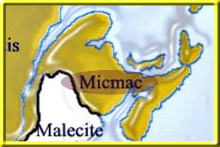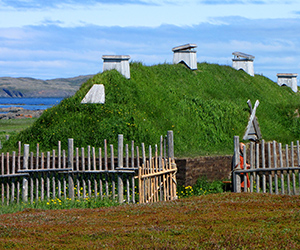CANADA HISTORY
Anishinaabe

The Anishinaabe are a group of Indigenous peoples in North America who have lived for thousands of years in the Great Lakes region, which includes parts of what are now the northeastern United States and southeastern Canada. They are composed of several related tribes, including the Ojibwe (Chippewa), Odawa (Ottawa), and Potawatomi, collectively known as the Council of Three Fires. The Anishinaabe have a rich and complex history, deeply rooted in their spiritual connection to the land, and their culture has endured despite the many challenges posed by European colonization and later developments in North America.
Culture and Social Structure
The Anishinaabe culture was deeply tied to the land and natural world. They were semi-nomadic, moving with the seasons to gather food, hunt, and fish. Their primary food sources included game animals such as deer and moose, as well as fish from the lakes and rivers. They also cultivated crops, primarily the "Three Sisters" (corn, beans, and squash), and gathered wild plants like berries, nuts, and maple sap, which they used to make syrup.
The clan system was a vital part of Anishinaabe society, providing structure and identity within the community. Each person belonged to a clan, often represented by an animal, such as the Bear, Loon, or Fish. This system, known as the doodem, organized social, political, and economic responsibilities, as well as leadership. Clans provided a sense of belonging and helped maintain order within the community. Decisions were often made through a consensus-based system, with discussions held among leaders of different clans. This system emphasized cooperation, respect for others' views, and peaceful negotiation, reflecting the importance of social harmony in Anishinaabe culture.
The Anishinaabe had a matrilineal kinship system, meaning that inheritance and descent were traced through the mother's line. Women played essential roles in family and community life, not only managing the household but also having a voice in community decisions. Extended families lived together in close-knit communities, reinforcing bonds of kinship and mutual responsibility.
Political Structure
The political organization of the Anishinaabe was decentralized, with each tribe and community having autonomy but maintaining connections through broader alliances, such as the Council of Three Fires. These alliances were not only for political and military purposes but also for cultural and economic exchange. Leaders, known as ogimaag or chiefs, were chosen based on their wisdom, oratory skills, and ability to resolve conflicts. Leaders did not hold absolute power, as decisions were generally made by councils that included elders, clan leaders, and other respected members of the community.
Warfare and Diplomacy
The Anishinaabe people were both skilled diplomats and formidable warriors. Inter-tribal warfare occurred for various reasons, including competition for resources, territorial disputes, and personal grievances. However, they also had a strong tradition of diplomacy and negotiation, and many conflicts were resolved peacefully. The Anishinaabe valued respectful dialogue and consensus-based decision-making in resolving disputes, both within their own society and with other tribes.
Despite their diplomatic tendencies, the Anishinaabe engaged in conflicts with neighboring tribes, including the Dakota and the powerful Iroquois Confederacy. These conflicts were often over control of hunting grounds and access to important trade routes. During the early European contact period, the Anishinaabe became key players in the fur trade, and their alliances with the French helped them counterbalance Iroquois expansion and aggression. The Anishinaabe maintained their role as vital fur trade intermediaries between Europeans and other Indigenous peoples.
Religious Beliefs
Anishinaabe spiritual beliefs were deeply rooted in animism, the belief that all things—animals, plants, rocks, and even inanimate objects—had a spirit or soul. Their connection to the natural world was expressed through rituals, prayers, and ceremonies aimed at maintaining balance between the physical and spiritual realms. Midewiwin, or the Grand Medicine Society, was a key religious institution among the Anishinaabe. This society preserved sacred knowledge and healing practices, acting as both a religious and medical authority.
Dreams and visions played an important role in Anishinaabe spirituality, providing guidance and insight into one’s life path. Individuals, especially young men, often went on vision quests to seek spiritual direction. The Anishinaabe had creation stories, songs, and dances that expressed their worldview, and these traditions were passed down through oral history.
Captivity and Slavery
The Anishinaabe had a system of captive-taking during warfare, but this was distinct from European chattel slavery. Captives were often adopted into the community and could become full members, with the rights and responsibilities of any other Anishinaabe person. This practice of adoption served both as a way to replace lost members of the community and to strengthen alliances. Captives were not treated as property, and their status was not based on race or ethnicity.
Territory and Geographic Area
Before European contact, the Anishinaabe occupied a vast territory that included parts of present-day Michigan, Wisconsin, Minnesota, Ontario, and Quebec. Their lands stretched around the Great Lakes, making them one of the most prominent Indigenous groups in the region. The vast network of lakes and rivers provided the Anishinaabe with a rich environment for fishing, hunting, and trade. Canoes, often made of birch bark, were the primary mode of transportation, allowing them to travel great distances for trade, warfare, and diplomacy.
European Contact and the Fur Trade
With the arrival of the French in the 17th century, the Anishinaabe became deeply involved in the fur trade. The French established trading posts around the Great Lakes, exchanging European goods such as firearms, iron tools, and textiles for beaver pelts, which were highly valued in Europe. The Anishinaabe played a crucial role in the fur trade, acting as middlemen between the French and other Indigenous groups further west. This economic relationship also led to military alliances, with the Anishinaabe fighting alongside the French against the English during various colonial conflicts.
After the French and Indian War, the British took control of the fur trade, and the Anishinaabe adjusted to new political realities. However, the expanding British and later American presence increasingly encroached on Anishinaabe lands. Treaties were often used by colonial governments to dispossess the Anishinaabe of their territories, leading to significant land loss and forced relocations.
Challenges and Continuity
The 19th and 20th centuries were difficult periods for the Anishinaabe, as they faced increasing pressure from European settlers, the U.S. and Canadian governments, and policies of forced assimilation. Many Anishinaabe children were taken from their families and placed in boarding schools, where they were forbidden from practicing their language, culture, and religion. The loss of land and traditional practices took a heavy toll on the community, but the Anishinaabe continued to resist and preserve their identity.
Despite these challenges, the Anishinaabe have maintained a strong sense of cultural identity. Today, many Anishinaabe communities are actively working to revitalize their language and cultural practices. Anishinaabemowin, the Anishinaabe language, is being taught to younger generations, and traditional ceremonies, songs, and dances are celebrated in communities throughout the Great Lakes region.
The Anishinaabe people have a rich history that spans thousands of years. From their deep spiritual connection to the land and natural world, their strong political and social structures, and their vital role in the fur trade, the Anishinaabe have played a significant part in the history of North America. Though they faced immense challenges due to European colonization, forced assimilation, and land dispossession, the Anishinaabe have persevered. Today, they continue to thrive, celebrating their heritage and advocating for their rights while ensuring that future generations remain connected to their traditions and history. The Anishinaabe remain a crucial part of the cultural and historical fabric of the Great Lakes region.
Cite Article : www.canadahistory.com/sections/documents




